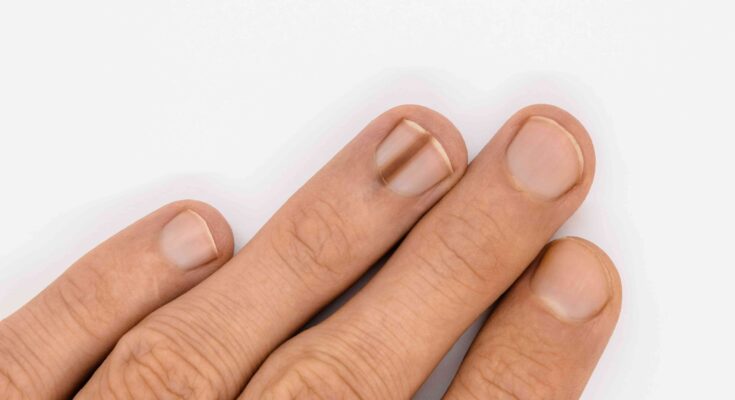A black line on the nail (often called melanonychia) may be a harmless variation, but in some cases it can signal something more serious. Below is an overview of causes, warning signs, diagnosis, treatment, and when to seek medical attention.
What Causes a Black Line on the Nail?
Many things can contribute to a dark vertical stripe on the nail. Some are benign, others more serious.
- Melanonychia: This is a dark discoloration (black or brown) of the nail plate, usually in a vertical (longitudinal) direction.
- Melanocytic activation: An increase in pigment (melanin) production without an increase in pigment cells.
- Melanocytic hyperplasia: Increase in number of pigment cells (which may be benign or malignant).
- Splinter hemorrhage: Tiny blood vessels under the nail break, causing a thin black or red line.
- Trauma or injury: Repeated microtrauma or a single impact can trigger lines or discoloration.
- Medications & treatments: Some chemotherapy drugs, antimalarials, and other systemic medications may lead to nail discoloration.
- Systemic diseases and syndromes: Conditions such as HIV, Addison’s disease, lupus, and others may have nail manifestations.
- Subungual melanoma (melanoma under the nail): A serious cause, though rare.
Other Symptoms & Warning Signs
When evaluating a black line on the nail, certain features may raise concern:
- The line is widening, darkening, or changing over time.
- The pigmentation extends to or involves the cuticle area (a sign called Hutchinson’s sign).
- It is present in only one nail, especially a thumb or big toe, without an apparent cause.
- Pain, bleeding, or nail deformity accompany the stripe.
- Multiple nails show lines, especially if you have systemic symptoms (fever, fatigue, skin changes).
How Is Diagnosis Made?
If a suspicious stripe is present, a health professional will typically:
- Take a medical history, including onset, duration, changes, medications, and any trauma.
- Perform a physical examination, assessing number of nails involved, width, color, pattern, and any extension into the surrounding skin.
- Use dermoscopy or magnified imaging to look for signs of malignancy (irregular lines, asymmetry, variation in color).
- In cases of concern, perform a biopsy (sampling tissue) to look for cancerous cells.
Treatment & Management
What you do depends entirely on the underlying cause:
- For benign melanonychia, often no treatment is needed — just monitoring.
- If a medication is the cause, your doctor may adjust the drug (if safe).
- Splinter hemorrhages usually resolve on their own as the nail grows out.
- If melanoma is detected, removal of the tumor, sometimes including parts of the nail and underlying tissue, is required.
- In advanced or invasive cases, surgery (including possible amputation in extreme cases) may be necessary.
When Should You See a Doctor?
You should seek professional evaluation if:
- The black stripe appears without any trauma, or you cannot explain it.
- The line is changing in size, color, or shape.
- It covers only one nail, especially a thumb or toe.
- You notice pain, bleeding, or nail distortion.
- You have a history of skin cancer or risk factors.
- You see changes in nail texture, thickness, or adjacent skin.
Early detection of nail melanoma significantly improves outcomes.
Key Takeaway
- Most dark lines on nails are benign, especially in people with darker skin tones.
- However, under certain warning signs (widening, pigment extension to cuticle, single-nail involvement, changes over time), the possibility of subungual melanoma must be considered.
- Consult a dermatologist if you notice an unexplained or evolving black line on your nail.



